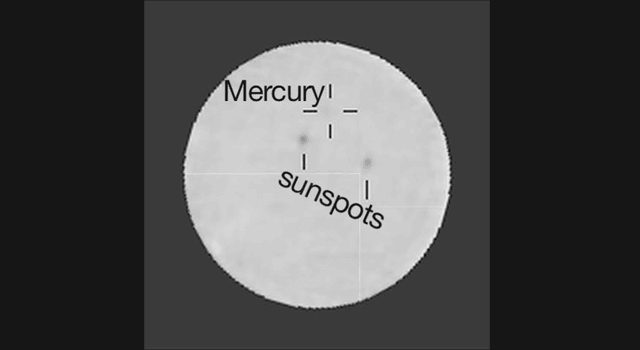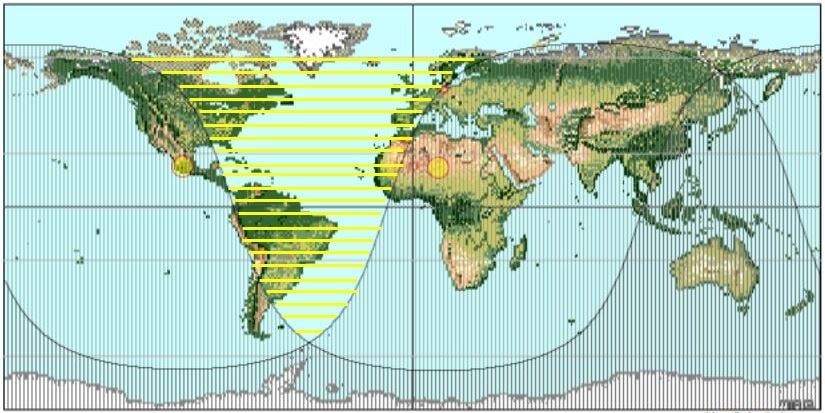When you look up at the sky to witness the transit of Mercury, make sure you use approved, specially-designed filters in your equipment, warns the Royal Astronomical Society, or you could risk permanent damage to the retina and even blindness. Never look straight up at the Sun with the naked eye.
The Royal Astronomical Society (RAS) warns:
“Looking directly at the Sun, either during the transit or at any other time, can cause permanent damage to the retina, leading to loss of vision or blindness.”
The transit of Mercury occurs when the smallest planet in our solar system – Mercury – passes directly between the Earth and the Sun. It is not like those eclipses when daytime can turn to nightime. Mercury is a very small planet and appears just as a tiny dot in front of a giant Sun.
 Transit of Mercury November 2006. It occurs when Mercury passes directly between the Earth and the Sun. Mercury appears as a tiny dot travelling across the Sun. (Image: mercury.ras.ac.uk)
Transit of Mercury November 2006. It occurs when Mercury passes directly between the Earth and the Sun. Mercury appears as a tiny dot travelling across the Sun. (Image: mercury.ras.ac.uk)
If you live travelling distance from central London, you should consider taking up the RAS’ invitation to the general public to come and enjoy the transit of Mercury in its premises using specially set-up equipment.
Transit of Mercury doesn’t happen often
Transits are not frequent events, says the RAS, the last time an event like the next transit of Mercury on 9th May occurred was in 2006 – the last such event in the UK occurred in 2003.
After Mercury’s transit this month, the next ones will take place in 2019 and 2032.
The RAS says everyone across the UK should be able to have a good view of the transit next week, as long as we have clear skies.
The whole event will run from 12:12 BST tto 19:42 BST. Sky-gazers will be able to see a silhouetted disk (Mercury) moving slowly against the bright solar surface.
 This transit of Mercury was captured by the Curiosity rover on Mars on 3rd June, 2014. Perhaps one day in the future, Mars colonists will be able to do the same. (Image: Wikipedia)
This transit of Mercury was captured by the Curiosity rover on Mars on 3rd June, 2014. Perhaps one day in the future, Mars colonists will be able to do the same. (Image: Wikipedia)
According to the RAS:
“Because the planet is so small, it only blocks out a tiny part of the light of the Sun. This means it is impossible to see Mercury, and dangerous to try to observe it with the unaided eye, or using a telescope or binoculars without approved specially designed filters.”
Special event in London
To allow members of the public to witness the transit of Mercury in safety, the RAS has organised a special event in the courtyard of Burlington House, Piccadilly, central London.
Professional astronomers will be on hand to help operate the telescopes, which have been fitted with safe solar filters.
If you are within travelling distance of central London on 9th May, the RAS urges you to come, where its staff will be on hand from midday until at least 4pm, and probably until the Sun sets over neighbouring buildings.
 If you plan to watch the transit of Mercury on 9th May, make sure your equipment has the appropriate, approved filters. In this image you can see members of University Lowbrow Astronomers at Ann Arbor, Michiga, USA, watching the 1999 transit. (Image: umich.edu/~lowbrows)
If you plan to watch the transit of Mercury on 9th May, make sure your equipment has the appropriate, approved filters. In this image you can see members of University Lowbrow Astronomers at Ann Arbor, Michiga, USA, watching the 1999 transit. (Image: umich.edu/~lowbrows)
The telescopes and other equipment will be mounted outside the Royal Academy.
The RAS will also be hosting a live feed of the transit of Mercury in its lecture theatre. Its library will hold a special mini-exhibition of Mercury materials. “Both of these rooms are located in our building on the opposite side of the courtyard to the telescopes,” says the RAS.
President of the RAS, Martin Barstow, who is also Professor of Astrophysics and Space Science at the University of Leicester’s Department of Physics and Astronomy, said:
“It is always exciting to see rare astronomical phenomena, such as this transit of Mercury. They show that astronomy is a science that is accessible to everyone, and I would encourage you to take a look if the weather is clear… but do follow the safety advice!”
 The horizontal yellow bars show where on Earth the 9 May transition of Mercury will be visible. (Image: adapted from European Space Agency pic)
The horizontal yellow bars show where on Earth the 9 May transition of Mercury will be visible. (Image: adapted from European Space Agency pic)
The transit of Mercury will be observable across the whole of Western Europe, South America, the eastern part of North America, West Africa, and the western region of North Africa.
The RAS wrote:
“Most of the transit (either ending with sunset or starting at sunrise) will be visible from the rest of North and South America, the eastern half of the Pacific, the rest of Africa and most of Asia. Observers in eastern Asia, south-eastern Asia and Australasia will not be able to see the transit.”
Every century there are from thirteen to fourteen transits of Mercury, which makes them relatively infrequent events. However, most of them are viewable from many parts of the world.
Pierre Gassendi (1592-1655), the French philosopher, priest, scientist, astronomer, and mathematician, was the first human to observe a transit (1631). This occurred two decades after the telescope had been invented.
The US space agency – NASA – makes the following comment regarding transits:
“Transit is the passage of a planet across the Sun’s bright disk. At this time, the planet can be seen as a small black disk slowly moving in front of the Sun. The orbits of Mercury and Venus lie inside Earth’s orbit, so they are the only planets which can pass between Earth and Sun to produce a transit.”
How did Mercury get its name?
The Romans were strong believers in gods and goddesses – they were convinced that they were in charge of everything on Earth.
They named Mercury after the messenger for their gods. The Roman Mercury had a helmet and shoes with wings on them. He could travel very rapidly from place to place.
The planet Mercury moves very fast around the Sun. According to NASA, that is how it got its name.
Video – Transit of Mercury simulation
This European Space Agency video contains a simulation of the transit of Mercury, 9th May, 2016 in CET (Central European Time).
